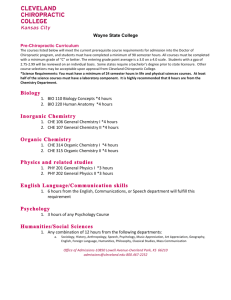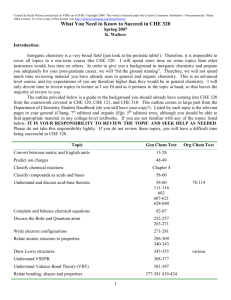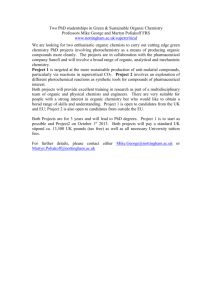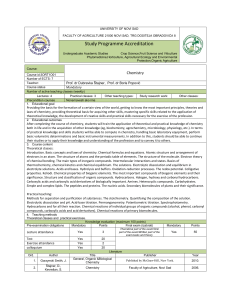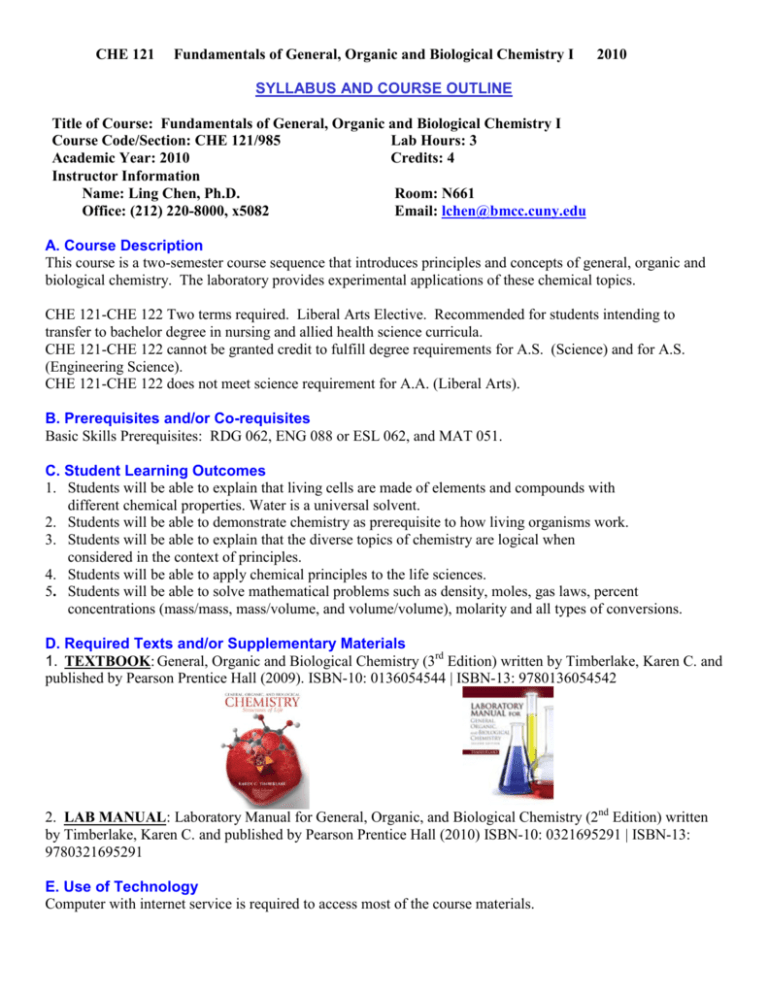
CHE 121
Fundamentals of General, Organic and Biological Chemistry I
2010
SYLLABUS AND COURSE OUTLINE
Title of Course: Fundamentals of General, Organic and Biological Chemistry I
Course Code/Section: CHE 121/985
Lab Hours: 3
Academic Year: 2010
Credits: 4
Instructor Information
Name: Ling Chen, Ph.D.
Room: N661
Office: (212) 220-8000, x5082
Email: lchen@bmcc.cuny.edu
A. Course Description
This course is a two-semester course sequence that introduces principles and concepts of general, organic and
biological chemistry. The laboratory provides experimental applications of these chemical topics.
CHE 121-CHE 122 Two terms required. Liberal Arts Elective. Recommended for students intending to
transfer to bachelor degree in nursing and allied health science curricula.
CHE 121-CHE 122 cannot be granted credit to fulfill degree requirements for A.S. (Science) and for A.S.
(Engineering Science).
CHE 121-CHE 122 does not meet science requirement for A.A. (Liberal Arts).
B. Prerequisites and/or Co-requisites
Basic Skills Prerequisites: RDG 062, ENG 088 or ESL 062, and MAT 051.
C. Student Learning Outcomes
1. Students will be able to explain that living cells are made of elements and compounds with
different chemical properties. Water is a universal solvent.
2. Students will be able to demonstrate chemistry as prerequisite to how living organisms work.
3. Students will be able to explain that the diverse topics of chemistry are logical when
considered in the context of principles.
4. Students will be able to apply chemical principles to the life sciences.
5. Students will be able to solve mathematical problems such as density, moles, gas laws, percent
concentrations (mass/mass, mass/volume, and volume/volume), molarity and all types of conversions.
D. Required Texts and/or Supplementary Materials
1. TEXTBOOK: General, Organic and Biological Chemistry (3rd Edition) written by Timberlake, Karen C. and
published by Pearson Prentice Hall (2009). ISBN-10: 0136054544 | ISBN-13: 9780136054542
2. LAB MANUAL: Laboratory Manual for General, Organic, and Biological Chemistry (2nd Edition) written
by Timberlake, Karen C. and published by Pearson Prentice Hall (2010) ISBN-10: 0321695291 | ISBN-13:
9780321695291
E. Use of Technology
Computer with internet service is required to access most of the course materials.
CHE 121
Fundamentals of General, Organic and Biological Chemistry I
2010
Firefox internet browser is required for the course assessments such as Quizzes and Practice Exercises.
Acrobat Reader is needed to open the course documents: Lecture Notes, Learning Checks and others.
A scientific calculator is required for labs and exams.
In addition to read the class materials online, you must participate in Discussion Board discussions from
Blackboard by posting one question and response to one of others’ postings for each chapter. Once a week we
have “chat hour” during Virtual Office Hour so your questions and concerns can be answered synchronously.
You may email me for any personal questions.
F. Evaluation and Requirements of Students
There will be total five exams: four-term examinations (total 40%), and a final examination (20%). You must
fulfill all laboratory assignments (total 20%). You must participate in class discussions via the Discussion
Board (total 5%) every week, complete one Quiz for each chapter (total 5%), and one Practice Exercise before
each exam (total 10%).
1. Time: You must dedicate a great deal of time to the readings and assignments. This course is as timeconsuming as the face-to-face course and you must be comfortable using a computer, the Internet, and are
highly motivated and disciplined to allot the appropriate amount of time every week to the course in order to
successfully complete the assignments on time.
2. Discussion Board Participation: You must post a question and response other’s posting by the due date.
After a specified date, you will no longer be available to complete the tasks.
3. Assignments: Due dates for Quizzes and Practice Exercises are listed in Study Schedule, which can be
found in Course Information and weekly folders. NO LATE WORK WILL BE ACCEPTED. Missing
assignments will negatively impact your final grade.
4. Laboratory: Weekly completion of assigned lab work (see Lab Schedule) is required. GRADES WILL BE
LOWERED FOR MISSING LABS. There is no make-up lab.
5. Exams: There will be total of five exams given in the course, i.e., one exam for every two or three chapters.
There is no make-up exam.
G. Final grade:
Your final grade will be based on the following guidelines:
►Participation in the discussion boards
►Quizzes
►Practice Exercises
► Labs
► Term examinations
► Final examination
5%
5%
10%
20%
40%
20%
Your final letter grade is given according to BMCC’s grading system:
%
93908783807773100%
92%
89%
86%
82%
79%
76%
Grade A
AB+
B
BC+
C
If you receive a C- or lower, see the F/C-grading policy
7072%
C-
6769%
D+
6366%
D
6062%
D-
CHE 121
Fundamentals of General, Organic and Biological Chemistry I
2010
G. Other Resources
Tutoring is available at the Science Learning Center (N734) and Science Resource Center (S500)
E-tutoring service is available at http://www.bmcc.cuny.edu/etutoring/.
Tech support is http://www.bmcc.cuny.edu/it/
Statement on Plagiarism
Plagiarism is the presentation of someone else’s ideas, words, or artistic, scientific, or technical work as
one’s own creation. Using the idea or work of another is permissible only when the original author is
identified. Paraphrasing and summarizing, as well as direct quotations require citations to the original
source. Plagiarism may be intentional or unintentional. Lack of dishonest intent does not necessarily
absolve a student of responsibility for plagiarism.
Students who are unsure how and when to provide documentation are advised to consult with their
instructors. The library has guides designed to help students to appropriately identify a cited work. The
full policy can be found on the BMCC’s web site,
Students with disabilities who require reasonable accommodations or academic adjustments for this course must
contact the Office of Services for Students with Disabilities (Room N-769; Telephone # 220-8180). BMCC is
committed to providing equal access to all programs and curricula to all students.
Measurements
1.1
Scientific Method
15 – 18
1.2
Measurement and Scientific Notation
18 – 21
1.3
Measured Numbers and Significant Figures
21 – 24
1.4
Significant Figures in Calculations
24 – 27
1.5
Prefixes and Equalities
27 – 32
1.6
Writing Conversion Factors
32 – 37
1.7
Problem Solving
37 – 43
1.8
Density
43 – 49
Energy
2.1
Energy
56 – 59
2.2
Temperature
59 – 63
2.3
Specific Heat
63 – 67
2.4
Energy and Nutrition
68 – 71
2.5
Classification of Matter
72 –74
CHE 121
2.6
2.7
Fundamentals of General, Organic and Biological Chemistry I
States and Properties of Matter
Changes of State
2010
75 – 79
79 –87
Atoms and Elements
3.1
Elements and Symbols
96 – 98
3.2
The Periodic Table
98 – 104
3.3
The Atom
105 – 107
3.4
Atomic Number and Mass Number
108 – 110
3.5
Isotopes and Atomic Mass
110 – 113
3.6
Electron Energy Levels
114– 119
3.7
Electron Configurations
119 – 126
3.8
Periodic Trends
126 – 131
Nuclear Chemistry
4.1
Natural Radioactivity
139 – 143
4.2
4.3
4.4
Nuclear Reactions
Radiation Measurement
Half-Life of a Radioisotope
143 – 149
150 – 153
153 – 156
4.6
Nuclear Fission and Fusion
160 – 161
Compounds and Their Bonds
5.2
Ionic Compounds
174 – 176
5.3
Naming and Writing Ionic Formulas
176 – 179
5.4
Polyatomic Ions
180 – 183
5.5
Covalent Compounds
183 – 189
5.6
Naming and Writing Covalent Formulas
189 – 192
5.7
Electronegativity and Bond Polarity
192 – 195
5.8
5.9
Shapes and Polarity of Molecules
Attractive Forces in Compounds
195 – 200
200 – 202
Alkanes
11.1
Organic Compounds
416 – 419
CHE 121
Fundamentals of General, Organic and Biological Chemistry I
2010
11.2
Alkanes
419 – 422
11.3
Alkanes with Substituents
423 – 429
11.4
Properties of Alkanes
429 – 434
11.5
Functional Groups
434 - 439
Chemical Reactions and Quantities
6.1
Chemical Reactions
211 – 216
6.2
Types of Reactions
216 – 221
6.3
Oxidation-Reduction Reactions
221 – 225
6.4
The Mole
226 – 230
6.5
Molar Mass
230 – 234
6.6
Mole Relationships in Chemical Reactions
235 – 237
6.7
Mass Calculations for Reactions
237 – 240
6.8
Energy Changes in Chemical Reactions
246 – 249
Gases
7.1
Properties of Gases
262 – 264
7.2
Gas Pressure
264 – 266
7.3
Pressure and Volume (Boyle’s Law)
267 – 270
7.4
Temperature and Volume (Charles’s Law)
270 – 273
7.5
Temperature and Pressure (Gay Lussac’s Law)
273 – 276
7.6
The Combined Gas Law
276 - 277
7.7
Volume and Moles (Avogadro’s Law)
277 – 281
7.8
The Ideal Gas Law
281 – 285
7.9
Partial Pressures (Dalton’s Law)
285 – 289
Solutions
8.1
Solutions
296 – 300
8.2
Electrolytes and Non Electrolytes
300 – 304
8.3
Solubility
305 – 312
8.4
Percent Concentration
312 – 316
CHE 121
Fundamentals of General, Organic and Biological Chemistry I
2010
8.5
Molarity and Dilution
316 – 321
8.6
Physical Properties of Solutions
322 – 329
Biomolecules
15.1
15.5
Carbohydrates
Disaccharides
543 – 545
557–563
17.1
Lipids
603 – 604
17.2
Fatty Acids
604 – 611
17.3
Waxes, Fats and Oils
611 – 614
19.1
Proteins and Amino Acids
673– 677
19.3
19.4
Formation of Peptides
Protein Structure: Primary and Secondary Levels
680 – 682
683-686
21.1
Components of Nucleic Acids
739 – 743
21.2
21.3
Primary Structure of Nucleic Acids
DNA Double Helix
743 – 745
745 -747
Chemical Equilibrium
9.1
Rates of Reactions
337 – 342
9.2
Chemical Equilibrium
342 – 344
9.3
Equilibrium Constants
344 – 348
9.4
Using Equilibrium Constants
349 – 353
9.5
Changing Equilibrium Conditions: Le Chatelier’s Principle
353 – 362
Acids and Bases
10.1
Acids and Bases
372 – 377
10.2
Strengths of Acids and Bases
377 – 383
10.3
Ionization of Water
383– 386
10.4
The pH Scale
386 – 393
10.5
Reactions of Acids and Bases
393 – 398
10.6
Acid-Base Properties of Salt Solutions
399 –401
10.7
Buffers
401 – 405
CHE 121
Fundamentals of General, Organic and Biological Chemistry I
Laboratory Syllabus
Expt
Title
Page
Laboratory Safety and Procedures
1
Measurement and Significant Figures
1
2
Conversion Factors in Calculations
11
3
Density and Specific Gravity
25
9
6
Energy and States of Matter
Nuclear Radiation
85
51
7
Compounds and Their Formulas
Electron Dot Structures and Molecular Shape
72
22
10
12
Structures of Alkanes
Chemical Reactions and Equations
Moles and Chemical Formulas
211
97
119
13
Gas Laws
129
16
Soluble and Insoluble Salts
159
15
Solutions, Electrolytes and Concentrations
147
11
Reaction Rates and Equilibrium
107
20
Acid-Base Titration
193
2010



